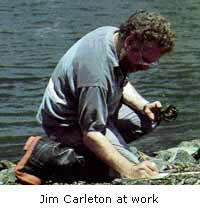Invasions at the Lake

 Lake
Merritt was the birthplace of an increasingly important field of
science--the study of marine invasions. It started in the early 1960s
when the staff of the Rotary Nature Center guided Oakland teenager Jim
Carlton into doing a science project on the animals in Lake Merritt. The
Lake, which is really a brackish-water lagoon and not a freshwater lake,
is home to an exotic stew of organisms from around the world. Carleton
found Korean shrimp, Japanese gobies, Australian tube-worms, Atlantic
Ocean sea squirts, and Mediterranean mussels. While still in high
school, he discovered a Chilean beach-hopper--a small shrimp-like
organism that does not occur anywhere else in North America. Carlton's
discoveries led to a career studying marine invasions. Today, he is the
world's leading expert in the field.
Lake
Merritt was the birthplace of an increasingly important field of
science--the study of marine invasions. It started in the early 1960s
when the staff of the Rotary Nature Center guided Oakland teenager Jim
Carlton into doing a science project on the animals in Lake Merritt. The
Lake, which is really a brackish-water lagoon and not a freshwater lake,
is home to an exotic stew of organisms from around the world. Carleton
found Korean shrimp, Japanese gobies, Australian tube-worms, Atlantic
Ocean sea squirts, and Mediterranean mussels. While still in high
school, he discovered a Chilean beach-hopper--a small shrimp-like
organism that does not occur anywhere else in North America. Carlton's
discoveries led to a career studying marine invasions. Today, he is the
world's leading expert in the field.
Andrew Cohen
University of California, Berkeley
 "Walk Along the Water"
"Walk Along the Water"
© Oakland Museum of California, used with permission.

 Explore this Topic:
Explore this Topic:
Jim Carlton's work on aquatic invaders in San Francisco Bay - PBS
 back to history map
back to history map